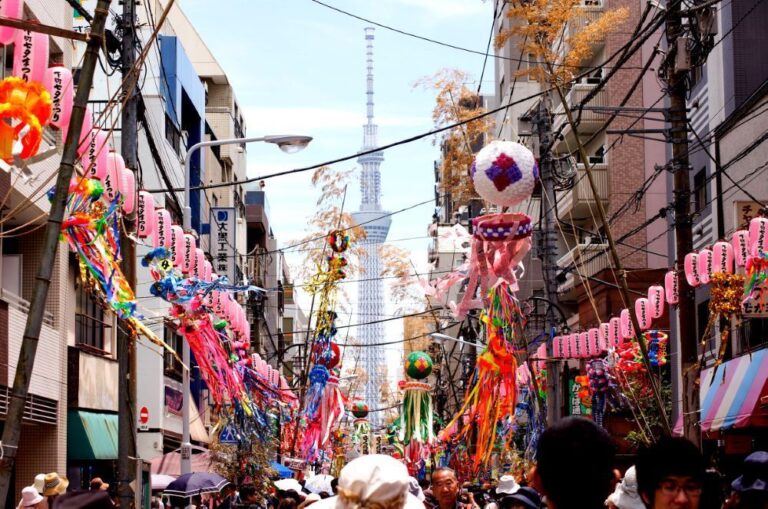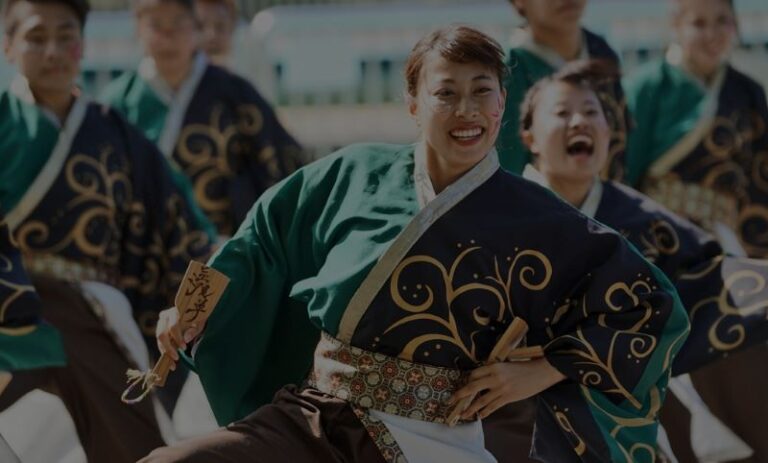Japanese Festivals There are numerous festivals in Japan, some based on local folklore, some having religious origins in Shintoism, Buddhism, Taoism and Christianity, and others deriving from harvest prayers or thanksgiving. Rich in seasonal and local colors, the festivals are not only entertainment for local people but also major attractions for tourists from other regions as well as from overseas.
Nebuta (Aomori Prefecture>)
One of the most prominent summer festivals in Japan, in which magnificent floats parade through the streets in a procession with dancers called haneto .
This is a traditional event of the Tanabata Festival in the Tsugaru region, said to have originated in a festival to dispel drowsiness that hindered farm work before the autumn harvest .
Huge lanterns, made with frames of wood or bamboo covered by Japanese paper, are lit and carried through the city before they are thrown to float into a river or the sea. The lanterns have magnificent warrior images painted on them modeled on historical characters.
The floats are preceded by haneto dancers performing to the music of drums and flutes. It is a dynamic festival to appreciate and praise the brief summer of the Tohoku region.
Kanto Matsuri (Akita Prefecture)
A summer night festival in which young men lift eight-meter-tall bamboo poles hung with 48 lit paper lanterns. The origin of the paper lanterns is a tall lantern to welcome the spirits of ancestors in the Bon Festival.
It later turned into an event to pray for a good autumn harvest, with paper lanterns resembling straw rice bags and the shape of the bamboo poles and lanterns resembling ears of rice.
Nine horizontal cross-poles are attached to each eight-meter-tall vertical pole, and 48 paper lanterns are suspended from them. Young men compete to best display the technique of shifting the poles from their shoulders to foreheads, then to their hips, etc. with musical accompaniment of flutes, drums and gongs.
When the audience in the stands shouts encouragement, calling out ” Dokkoisho ,” they display their stunts. This captivating and graceful festival is popular with Japanese people as well as tourists from overseas.
Sendai Tanabata Festival (Miyagi Prefecture)
A Chinese legend about the Weaver Star (Vega) and the Cowherd Star (Altair) on either side of the Milky Way was introduced to Japan and became the origin of the Tanabata Festival.
In the festival, which is popular throughout Japan, bamboo branches are decorated with narrow strips of colored paper on which people write their wishes. The Tanabata Festival sometimes coincides with the Bon Festival, as they are both seasonal summer festivals.
The Tanabata Festival in Sendai, the center of the Date family’s Sendai domain in the Edo Period, is especially splendid. Many tourists stroll around observing the decorated bamboo branches installed on both sides of arcaded shopping streets.
Awa Dance (Tokushima Prefecture)
Numerous groups of dancers parade to the accompaniment of lilting music. The Awa Dance originated from furyu odori (elegant dance), popular in Kyoto in the Muromachi Period (1338-1573), and developed into its present form with the influence of dance in Kabuki, traditional entertaining performances at indoor parties, and shamisen music. Each group of dancers, called ren , parade in formation in front of the audience in the stands to show off their choreography and dynamism to win the contest.
It is a Japanese version of the Rio Carnival — dancers and audience share the excitement for days and nights. In many parts of Japan, people wishing to have festivals like the Awa Dance, in which all the participants feel connected, have started organizing their own local festivals.
Kyoto Gion Festival
Kyoto Gion Festival begins on July 1 with Naginata Hoko-cho parish children visiting Yasaka Shrine to pray for the safe occurrence of the festival, followed by various Shinto rituals. The high point of the festival is the parade of floats on July 17.
This is followed by several other Shinto observances at various places in the city, such as the tea dedication on July 23, the parade of floats with large umbrellas on July 24, the dedication of the kyogen play on July 25, a ceremony to report completion of the rituals on July 29, and finally, the Nagoshi Festival at Eki Shrine on July 31.
The Gion Festival’s float event is designated as an important intangible ethnic and cultural heritage, and the floats are designated as important ethnic and cultural properties.
Karatsu Kunchi (Saga Prefecture)
Karatsu Kunchi, designated as part of Japan’s important intangible ethnic and cultural heritage, is an autumn festival at the Karatsu Shrine. For three days from November 2, the festive atmosphere envelopes the whole town of Karatsu.
Fourteen floats with huge lanterns representing sea bream, lions, samurai helmets and other designs are carried swinging through the town. Every year, over 150,000 spectators crowd both sides of the street and give thanks for the year’s harvest. After the festival, the floats are exhibited in the float museum behind Karatsu Shrine.
Facing the Genkai Sea to the north, Saga Prefecture is also abundant in fresh marine products.
Hakata Dontaku (Fukuoka Prefecture)
Hakata Dontaku, said to have originated from Hakata matsubayashi festival music, is today a people’s festival named the Hakata Dontaku Harbor Festival. On May 3 and 4 every year, local citizens in costumes march through the town, clapping rice scoops. The Dontaku parade visits houses and is treated to cold sake , kombu (kelp), dried cuttlefish, boiled fish paste, etc. The origin of the word Dontaku is the Dutch word zondag , meaning “holiday.”
Sapporo Snow Festival (Sapporo)
Large and small snow statues are exhibited along Odori Boulevard, Sapporo’s main street, and other venues over a distance of about 1.5 kilometers.
They are beautifully illuminated at night.
Some statues are as tall as four- to five-story buildings, and are constructedt by firmly compressing snow over a wooden frame according to a design drawing and model.
Then the mass of snow is carved like a sculpture and elaborate details are engraved. The first Sapporo Snow Festival was held in 1950, and the 55th festival takes place in 2004.
Held usually for seven days from February 5 to 11, the festival attracts over 2 million tourists, including 20,000 from overseas. In the 43rd festival in 1992, a record number of 366 statues were exhibited.
Kanda Sanja Festival (Tokyo)
A festival of the Asakusa Shrine, where the three gods, Haji no Matsuchi no Mikoto, Hinokuma Hamanari no Mikoto, and Hinokuma Takenari no Mikoto are enshrined. They are related to the legendary coming of the god Kannon to the adjacent Sensoji Temple.
The name Sanja Festival means “festival of three gods.” The annual festival will be held for four days in 2004 from May 13, at which time the spirits are invited to enter the mikoshi (portable shrines). Other features include a great parade, dedication of the dance binzasara no mai , a parade of community mikoshi and the procession of the shrine’s mikoshi on the final day of May 16.
Nagasaki Okunchi (Nagasaki)
Nagasaki Okunchi was originally the Chrysanthemum Festival celebrated on September 9. The name Okunchi is said to come from the word meaning “ninth day.” Today, the festival takes place in October.
This is a festival of the Suwa Shrine, and its highlight is the Dragon Dance of Chinese origin. Nagasaki was where many foreign goods and customs were introduced, as it was the only Japanese port opened to international trade during the Edo period. Each one of six districts in Nagasaki takes turns to dedicate dance and other performances. For their turn, people in the district , called odorimachi , spend seven years preparing for the performances. For the three days of the festival, the whole city is in a very festive mood.Top of page
- February 5-11Sapporo Snow Festival
- May 3-4Hakata Dontaku
- MaySanja Festival (Tokyo)
- JulyGion Festival (Kyoto)AugustNebuta (Aomori), Kanto (Akita), Hanagasa Festival (Yamagata), Awa Dance September Kaze no Bon (Yao Town, Toyama Prefecture)November 2-4Karatsu Kunchi (Karatsu, Saga Prefecture)




